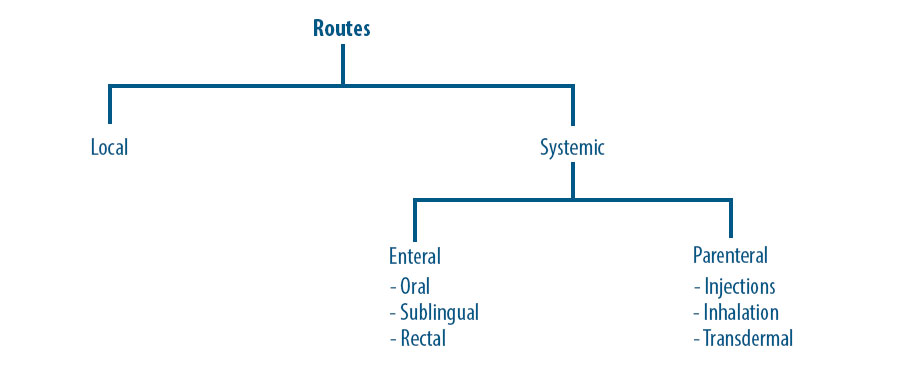Explain Different Routes of Medicine Administration
Intradermal injecting a drug into the first layers of the skin Subcutaneous injecting directly into the fatty tissue under the skin Intramuscular injecting directly into a muscle Intraarterial injecting a drug directly into an artery. 33 Describe the common adverse reactions to medication and the appropriate actions required in line with agreed ways of working.

Routes Of Drug Administration An Overview Pharmapproach Com
Routes of Medication Administration When giving medications by mouth such as pills or liquids there are some basic things to remember.

. All the routes of drug administration need to be understood in terms of their implications for the effectiveness of the drug therapy and the patients experience of drug treatment. Many individuals can only swallow one pill at a time. Little absorption occur in stomach because of small area and short residence time.
1 Route of Administration 2 Drug permeability 3 Drug metabolism at the site 4 Blood circulation or perfusion at the site 5 Drug release from the dosage form What factors affect administration. 1 Physiology at the absorption site 2 Transporters. 4 Be able to prepare for the administration of medication.
Oral Swallowed through the patients mouth as either a tablet liquid capsule lozenge or chewable tablet. The main role of any route is to deliver the drug to the target part of the body so it can give its therapeutic effect. 32 Explain the different routes of medicine administration.
Rectal This may be the next option for those who cant swallow the medication. The route used to give a drug depends on three main factors. Medication administration is a clinical procedure in that medications are used for the body to treat or cure from the medical condition.
Medications delivered to the distal one-third of the rectum at least partially avoid the first pass effect through the liver which allows for greater bio-availability of many medications than that. Oral route Sublingual Buccal route Rectal route Topical route Transdermal route Inhalational route pulmonary route Injection route 1. The rectal route is an effective route of administration for many medications especially those used at the end of life.
Understanding routes of administration. The local route is the simplest method of drug administration at the site where preferred action of the drug is required and in systemic routes medication is usually administered using two major routes ie. Oral route This is the most frequently used route for drug administration.
Different routes of drug administration The main routes of drug administration include. 41 Explain the importance of the appropriate timing of medication. There are various routes of administration available each of which has associated advantages and disadvantages.
Medications are taken by mouth either as liquids capsules. It describes any medication injected into the body via the following routes. L Different routes used to administer medicines l Benefits and limitations of the different administration routes l Points to consider before administering medicines Clinical.
Subcutaneous under the skin Intramuscular in a muscle Intravenous in a vein Intrathecal around the spinal cord A drug product can be prepared or manufactured in ways that prolong drug absorption from the injection site for hours days or longer. Routes of Drug Administration. Medication and their uses.
Make sure that the individual is in an upright and sitting position. Every disease has a cure. The drug is administered rectally as a suppository.
Every cure needs medicine and each medicine can be introduced to the body through different routes. Be careful to give. For example intravenous IV furosemide administered too quickly can cause deafness.
Citation Shepherd M Shepherd E 2020 Medicines administration 1. Administration by injection parenteral administration includes the following routes. The routes of drug administration are classified into local routes and systemic routes.
Explain the different routes of medicine administration. Routes of medication administration are described in the table below. Explain the different routes of medicine administration Routes of administration are usually classified by application location or exposition.
Enteral route and paternal route. Via skin eyes ears nose vagina rectum lungs inhaled Parenteral. Orally administered drugs absorbed mainly from small intestine.
Oral penicillin V given with food will not be well absorbed. The route or course the active substance takes from application location to the location where it has its target effect is usually rather a matter of pharmacokinetics. Never give pills or liquids to an individual lying down.
The part of the body being treated the way the drug works within. Over-application of topical steroids will cause thinning of the skin and may lead to systemic side-effects. The oral route is the most frequently used route of medicines administration and is the most convenient and.
The walls of the rectum absorb many medications quickly and effectively. There are various routes to administer the drug. Routes of medicine administration Oral administration.
24 Explain the different routes of medication administration. To get a better understanding here are the 6 most common routes. The different routes of medicine administration.
Influx and efflux What are influx transporters. Oral by mouth and swallow Buccal by the buccal cavity Sublingual underneath the tongue Inhaled through the mouth or nose Topical on the skin Transdermal a patch on the skin Intra-ocular. Drug administration by mouth and tube feeding using nasogastric gastrostomy and jejunostomy tubes.
View the full answer Previous question Next question. When you take drugs by mouth and drug is absorbed from the GI tract.

Comparison Of Three Different Routes Of Drug Administration Oral Download Scientific Diagram

Advantages And Disadvantages Of Different Routes Of Administration For Download Table

No comments for "Explain Different Routes of Medicine Administration"
Post a Comment